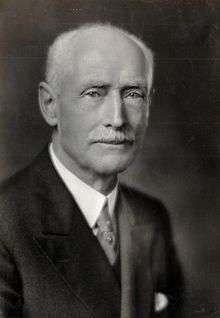Carl Seashore

Carl Emil Seashore, born Sjöstrand (January 28, 1866 – October 16, 1949) was a prominent American psychologist and educator. He was the author of numerous books and articles principally regarding the fields of speech-language pathology and music education. He served as Dean of the Graduate College of University of Iowa. He is most commonly associated with the development of the Seashore Tests of Musical Ability. [1] [2] [3]
Background
Seashore was born in Mörlunda, Hultsfred Municipality, Kalmar County, Sweden to Carl Gustav and Emily Sjöstrand. He emigrated with his family to the United States in 1870 and settled in Iowa. The name “Seashore” is a translation of the Swedish surname Sjöstrand. He graduated from Gustavus Adolphus College in St. Peter, Minnesota during 1891, having studied mathematics, music, classical languages and literature. During his years in college he served as the organist and choir director of a local Swedish-American Lutheran church and his salary there paid most of his college expenses. Seashore became a member of the Iowa Beta chapter of Sigma Alpha Epsilon.[4]
Seashore attended Yale University when that school had just opened the Graduate Department of Philosophy and Psychology. He studied under George Trumbull Ladd, professor of metaphysics and moral philosophy. In 1877, Ladd had authored the standard American textbook Elements of Physiological Psychology. In 1895, Seashore was awarded the school’s first Ph. D in psychology for his dissertation on the role of inhibition in learning.[5] [6] [7]
Career
After a trip to Europe and a subsequent fellowship at Yale, he accepted a permanent position at the University of Iowa where he spent the remaining 50 years of his life. In 1905, he was made chairman of the Philosophy and Psychology Department and in 1908, he was made Dean of the Graduate School. [8] [9]
Seashore was particularly interested in audiology, the psychology of music, the psychology of speech and stuttering, the psychology of the graphic arts and measuring motivation and scholastic aptitude. Seashore used standardized tests to measure how performance deviated from indicated markings and how musical aptitude differed between students. He devised the Seashore Tests of Musical Ability in 1919, a version of which is still used in schools in the United States. The test involved controlled procedures for measuring respondent's ability to discriminate pitch, loudness, tempo, timbre, and rhythm.[10]
His interests in the fine arts led to a joint effort with Dr. Norman Charles Meier (1893-1967) and the publication of the Meier-Seashore Art Judgment Test in 1929. During the early 1930s, he received financial support for his research from the Bell Laboratories. Among the larger projects that he supervised was one at the Eastman School of Music with financial assistance from George Eastman. His complete publication list from 1893 to 1949 includes 237 books and articles.[11] [12]
Honors
- Awarded Honorary Doctor of Science degree from Yale University in 1935
- Awarded Honorary Doctor of Musical Arts degree from the Chicago Musical College in 1939
- Elected to the National Academy of Sciences
- Member of the Acoustical Society of America
- Member of the American Musicological Society
- Honorary fellow of the British Psychological Society
Selected works
- Elementary Experiments in Psychology (New York, H. Holt and Company, 1908)
- The Measurement of Musical Talent (New York, G. Schirmer, 1915)
- The Psychology of Musical Talent (New York: Silver, Burdett and Company, 1919)
- Introduction to Psychology (New York, Macmillan, 1923)
- Approaches to the Science of Music and Speech (Iowa City, The University, 1933)
- Psychology of Music (New York, London, McGraw-Hill Book Company, Inc., 1938)
- Why we love music (Philadelphia, Oliver Ditson company, Theodore Presser co., distributors, 1941)
- In Search of Beauty in Music : a scientific approach to musical esthetics (New York, The Ronald Press Company, 1947)
References
- ↑ Walter R. Miles. "Carl Emil Seashore" (PDF). National Academy of Sciences. Retrieved December 15, 2015.
- ↑ Judith Felson Duchan (May 12, 2011). "Carl Emil Seashore 1866-1949". A History of Speech - Language Pathology. Retrieved December 15, 2015.
- ↑ Milton Merfessel (30 June 1950 ) Memorial: Carl Emil Seashore, 1866-1949 (Science: Vol. 111 no. 2896 pp. 713-717)
- ↑ Dr. Seashore Ranked as One of Top Alumni (Dr. John S. Kendall, Professor of Psychology and President of Gustavus Adolphus College)
- ↑ Stoddard, George D. "Carl Emil Seashore: 1866-1949", The American Journal of Psychology, Vol. 63, No. 3 (Jul., 1950), pp. 456-462, University of Illinois Press.
- ↑ Laird Addis. "Carl Emil Seashore 1866-1949". The Biographical Dictionary of Iowa. Retrieved December 15, 2015.
- ↑ "Carl Emil Seashore - 1945". Kappa Delta Pi, International Honor Society in Education. 2015. Retrieved December 15, 2015.
- ↑ Edwin E. Gordon. "The Legacy of Carl E. Seashore" (PDF). University of South Carolina. Retrieved December 15, 2015.
- ↑ S. J. Linton. "Carl Emil Seashore, a Pioneer on Two Frontiers". Swedish-American Historical Quarterly v.31, no.2, p. 122-128. Retrieved December 15, 2015.
- ↑ James L. Mursell (May, 1931) An Evaluation of the Seashore Tests (Music Supervisors' Journal Vol. 17, No. 5 pp. 62,64-65)
- ↑ Carl E. Seashore (April 5, 1929) Art Judgment: A Measure Related to Both Personality and Intelligence? (Science: Vol. 69 no. 1788 p. 380)
- ↑ "Norman C. Meier Papers". The University of Iowa Libraries, Special Collections & University Archives. Retrieved December 15, 2015.
Further reading
- Miles, Walter R. (1956) In Biographical Memoirs (pages 256-316) (NY: Columbia University Press)
- Addis, Laird (2008) Carl Emil Seashore in Iowa Biographical Dictionary (edited by David Hudson, Marvin Bergmann, and Loren Horton, University of Iowa Press, 447-448)
External links
- Picture, biography and bibliography in the Virtual Laboratory of the Max Planck Institute for the History of Science
- The Personal Papers of Carl Emil Seashore are available for research use at the Gustavus Adolphus College and Lutheran Church Archives.
| Educational offices | ||
|---|---|---|
| Preceded by Walter Bowers Pillsbury |
20th President of the American Psychological Association 1911-12 |
Succeeded by Edward Lee Thorndike |